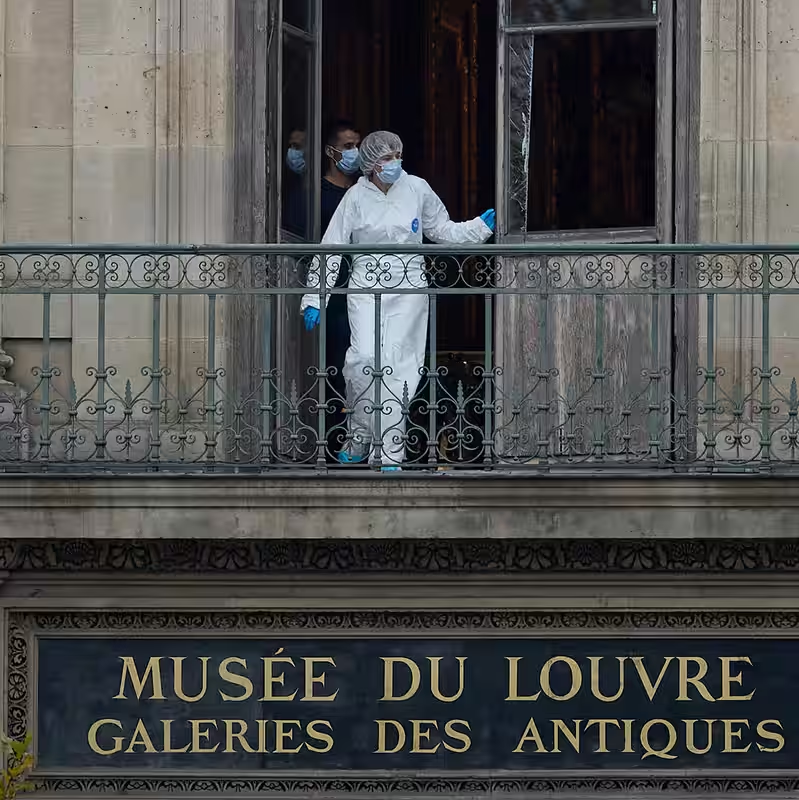Louvre Jewel Heist Shakes Paris—and the Art World
On the morning of October 19, 2025, visitors to the Louvre Museum in Paris got more than they bargained for. What began as a routine cultural outing turned into a front-row seat to one of the most audacious museum heists in modern history.
What Happened During the Louvre Jewel Heist?
At precisely 9:34 a.m., masked intruders smashed through a second-floor window of the Apollo Gallery using a stolen electric ladder and industrial-grade disc grinders. Within minutes, they made off with over $100 million in royal jewels—including Napoleon’s emerald-and-diamond wedding gift to Empress Marie-Louise and Queen Marie-Amélie’s sapphire tiara.
Witnesses like Holly Barker, a middle-school teacher from Indianapolis, described the chilling moment: “It sounded like gunfire. We thought it was a terrorist attack.” Museum staff quickly evacuated the gallery, but not before the thieves had already targeted specific display cases with unnerving precision.
Security Lapses That Enabled the Theft
Despite housing some of the world’s most priceless treasures, the Louvre’s perimeter security was shockingly outdated. According to museum director Laurence des Cars, only five external cameras monitor the entire outer facade—and the one covering the Apollo Gallery balcony was pointed in the wrong direction.
This critical blind spot meant security guards didn’t see the thieves ascend the ladder until it was too late. By the time police were alerted—after the window was already breached—it took just three minutes for officers to arrive… but the thieves were gone in under six.
Clues Left Behind—and Why It Matters
Despite their meticulous planning, the thieves panicked during their escape. They abandoned a motorcycle helmet, yellow work vests, gloves, power tools, and even the crown of Empress Eugénie on the street below. Forensic teams have since collected over 150 DNA and fingerprint samples.
“Even when well-prepared, thieves often make mistakes due to rushing,” said Olivier Halnais, head of France’s forensic police union. One suspect was arrested at Charles de Gaulle Airport trying to flee to Algeria; another was caught in a Paris suburb. Two accomplices remain at large.
Why the Apollo Gallery Was Targeted
The Apollo Gallery isn’t just any wing—it’s a glittering homage to French monarchy, often called the “Hall of Mirrors of the Louvre.” The stolen items weren’t randomly chosen:
| Item | Owner | Estimated Value |
|---|---|---|
| Emerald & Diamond Necklace | Empress Marie-Louise (Napoleon’s wife) | $40M+ |
| Sapphire Tiara & Earrings Set | Queen Marie-Amélie | $35M+ |
| Empress Eugénie’s Crown | Wife of Napoleon III | $25M+ |
These weren’t just jewels—they were symbols of France’s imperial past. Their loss has left curators and historians reeling.
Broader Implications for Global Museums
The heist has sparked urgent debates about museum security worldwide. The British Museum, by comparison, uses dozens of perimeter cameras on a smaller footprint. Experts warn that without AI-assisted surveillance and updated protocols, other institutions remain vulnerable.
“Construction workers are everywhere in Paris,” said Vincent Annereau of the Paris police. “Without smart monitoring, we can’t distinguish threat from routine.”
Will the Jewels Be Recovered?
Investigators fear the thieves may already be melting down the pieces or selling stones on the black market. Over 100 officers are racing to track the loot before it vanishes forever. So far, no items have been recovered.
For visitors like Holly Barker, the emotional toll lingers. “I might’ve been one of the last people to see that necklace,” she said from Indiana. “I just hope it’s not gone forever.”




